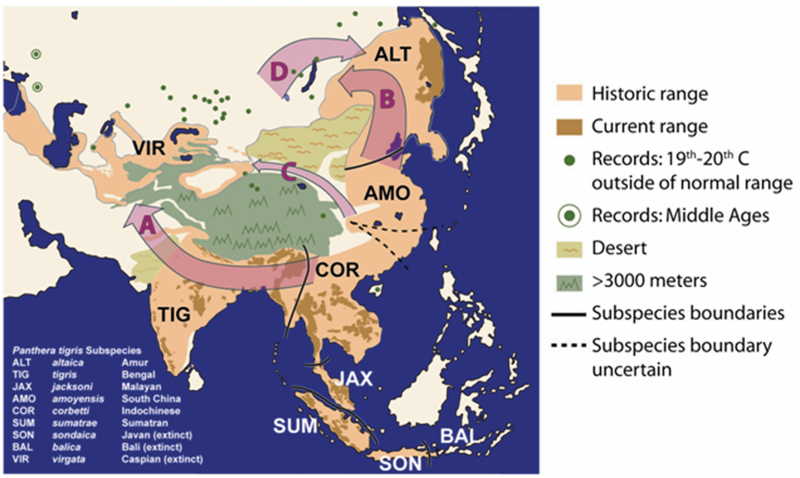Archivo: Historical tiger distribution PLoS 2009

Description: Historical range of tiger distribution is shown in light tan and current range is shown in dark tan, while green dots indicate individual historical recordings of tigers outside of normal distribution. Green ‘O’ indicate records from the Middle Ages. Black lines demarcate presumed subspecies boundaries. Abbreviations correspond to traditionally named tiger subspecies, arranged chronologically by date of naming. 1) tigris Linnaeus, 1758; 2) virgata Illiger, 1815; 3) altaica Temminck, 1844; 4) sondaica Temminck, 1844; 5) amoyensis Hilzheimer, 1905; 6) balica Schwarz, 1912; 7) sumatrae Pocock, 1929; 8) corbetti Mazak, 1968; 9) jacksoni Luo et al., 2004. Lettered arrows indicate postulated dispersal avenues: (A) Indian, southern route; (B) Siberian, northern route; and (C) Silk road/ Gansu route with (D) secondary eastward dispersal. See text for details. Redrawn from Figures 19 and 20 in Mazak (1983) and Figure 1 in Kitchener and Dugmore (2000). Doi:info:doi/10.1371/journal.pone.0004125.g001
Title: Historical tiger distribution PLoS 2009
Credit: Driscoll CA, Yamaguchi N, Bar-Gal GK, Roca AL, Luo S, et al. (2009) Mitochondrial Phylogeography Illuminates the Origin of the Extinct Caspian Tiger and Its Relationship to the Amur Tiger. PLoS ONE 4(1): e4125. doi:10.1371/journal.pone.0004125 (http://www.plosone.org/article/info:doi/10.1371/journal.pone.0004125)
Author: Driscoll CA, Yamaguchi N, Bar-Gal GK, Roca AL, Luo S, et al.
Usage Terms: Creative Commons Attribution 2.5
License: CC BY 2.5
License Link: http://creativecommons.org/licenses/by/2.5
Attribution Required?: Yes
Usos del archivo
La siguiente página enlaza a este archivo:

